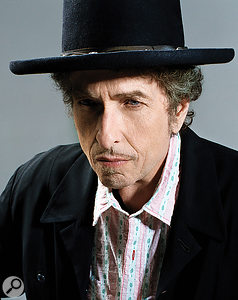Article Preview :: Inside Track: Secrets Of A Mix Engineer
People + Opinion : Artists / Engineers / Producers / ProgrammersBob Dylan’s album of Sinatra covers is an unlikely triumph. So good, in fact, that it didn’t need mixing!
Paul Tingen

The news that Bob Dylan was set to release an album of Frank Sinatra covers left many people scratching their heads. Dylan’s gritty, nasal voice has always been the antithesis of Sinatra’s mellifluous crooning, and over the last couple of decades, has deteriorated to the point where it’s at times little more than a tuneless rasp. To tackle 10 classics of the Great American Songbook armed only with this weapon seemed a bridge too far, and many feared the worst.

However, as so often happened during his long and chequered career, Shadows In The Night confounded expectations. Perhaps because he’s singing more softly and not straining his voice, the 73–year old Dylan manages to hold the often elaborate tunes quite beautifully, and the fragile and wavering quality of his singing only adds to the poignancy of the songs. “It shouldn’t work,” wrote one critic, “but Shadows In The Night is quite gorgeous.”
Uncover Versions
The surprising depth and quality of Dylan’s vocals is only one of several factors that make Shadows In The Night such a distinctive artistic success. Another is the minimalist and sensitive arrangements, played by Dylan’s live band, with the occasional addition of some understated horns — there are none of the orchestral or big–band arrangements that were the essence of Sinatra’s approach. Many reviewers also noted the compelling general ambience and “amazing” sound of the album. This stemmed from Dylan and his band being recorded in a straightforward, old–fashioned manner, resulting in a sonic warmth and intimacy that perfectly complements the late–night melancholy of the songs and performances.
“I’ve wanted to do something like this for a long time,” wrote the singer, “but was never brave enough to approach 30–piece complicated arrangements and refine them down for a five–piece band. That’s the key to all these performances. We knew these songs extremely well. It was all done live. Maybe one or two takes. No overdubbing. No vocal booths. No headphones. No separate tracking, and, for the most part, mixed as it was recorded. I don’t see myself as covering these songs in any way. They’ve been covered enough. Buried, as a matter a fact. What me and my band are basically doing is uncovering them. Lifting them out of the grave and bringing them into the light of day.”
Al Schmitt, teaching a masterclass at Mix With The Masters.Al Schmitt, teaching a masterclass at Mix With The Masters.Inside TrackIn other words, while Dylan’s musical approach was very different to Sinatra’s, the recording process for Shadows In The Night was very much of a piece with the way records were done in the ’50s. And if you intend to record in that way, who best to call than someone who was actually there at the time, and who even worked with Sinatra? Enter Al Schmitt, most likely the recording engineer with the longest career of any still active.
Harry’s Game
Schmitt first set foot in a recording studio during World War Two when, as a young boy, he assisted his uncle Harry Smith at Harry Smith Recording in Manhattan. He has since gone on to become the most venerated engineer and mixer in the history of music, with a record–breaking 23 Grammy Awards to his name, and a set of credits that could easily fill a book, including legendary names like Henry Mancini, Sam Cooke, Jefferson Airplane, Barbra Streisand, Steely Dan, George Benson, Toto, Miles Davis, Natalie Cole, Diana Ross, Elvis Costello, Luther Vandross, Neil Young, Brian Wilson, Paul McCartney and many, many others.
Surprisingly, however, Schmitt had never worked with Dylan before the call came from the singer’s manager, Jeff Rosen. “Unfortunately, I was busy at the time they had planned,” remembers Schmitt, on the phone from his Los Angeles home. “I was really disappointed, because Dylan was still on the bucket list of artists I’d love to work with, but never had. The very next day I got a call back, saying that they were prepared to move their schedule to a time when I was available, because Bob really wanted to work with me. Evidently he’d heard my work, including the Duets [1993] album I had recorded with Sinatra, and he must Published in SOS May 2015
No comments:
Post a Comment